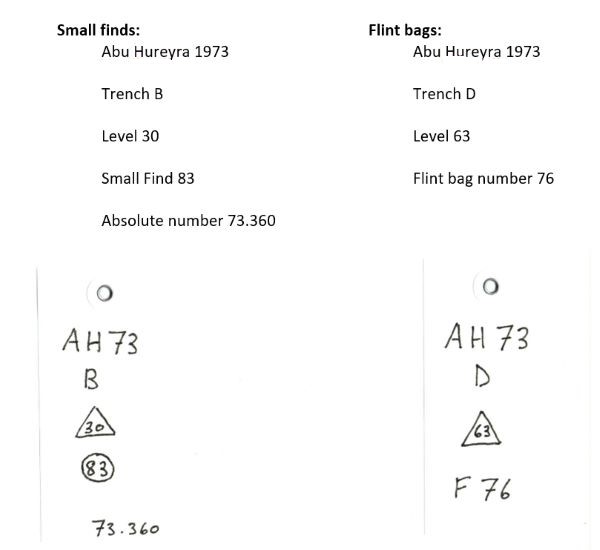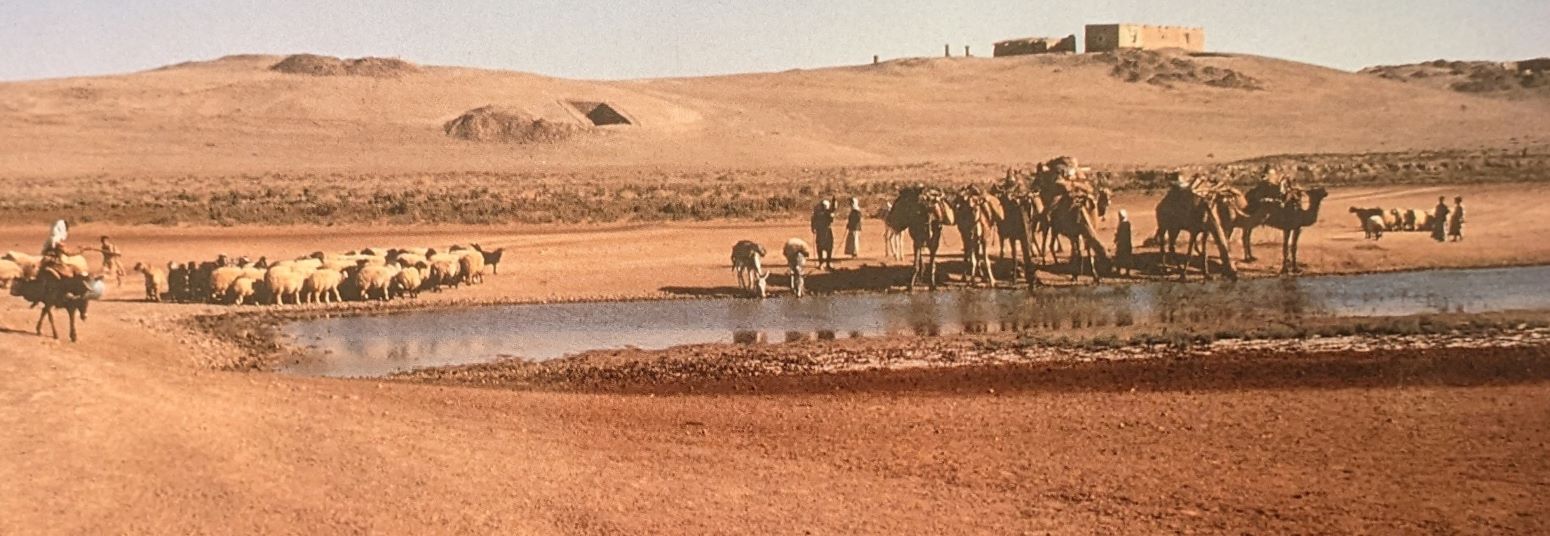Abu Hureyra Digital Data Archive
Data recovered from the archaeological excavation of the early village of Abu Hureyra
Project Abstract
Overview:
This project contains many of the data recovered from the archaeological excavation of the early village of Abu Hureyra. These data form part of the evidence used to write the book Village on the Euphrates by A.M.T. Moore, G.C. Hillman, and A.J. Legge that was published by Oxford University Press in 2000. Here, you may also learn more about the Abu Hureyra project and the people conducting the research on this important archaeological site.
Abu Hureyra (35° 52’ N, 38° 24’ E) was located in the valley of the Euphrates River in modern Syria. It was inhabited from c. 11,500 to 7,000 years ago in radiocarbon years. The village was founded by a group of hunters and gatherers who adopted agriculture c. 11,000 BP, becoming the first known farmers in the world. Following the development of farming, the population grew and the village of Abu Hureyra expanded until it became one of the largest settlements of its age in the Middle East.
Abu Hureyra is significant because it documents the transition from foraging to farming in one of the world's primary centers of agricultural development. Abu Hureyra was inhabited during the transition from Pleistocene to Holocene, a major climatic event that caused significant environmental change. The village was occupied for over 4,500 radiocarbon years, an extraordinary span of continuous habitation that has provided a unique record of early village life. Because Abu Hureyra was occupied for so long, we have been able to study the impact of the changes in climate and environment on the development of a farming way of life at a single site. The adoption of agriculture had profound effects on the community of people that lived there and was largely responsible for the extraordinary growth of the village.
We used modern methods of recovery on an unusually large scale to ensure maximum recovery of artifacts and food remains. All the excavated soil was passed through dry sieves to recover artifacts and bones. Large soil samples from each level were processed further by flotation to extract carbonized plant remains and small bones. These huge samples of organic remains have enabled us to study the economic changes at Abu Hureyra in unprecedented detail.
We encourage you to examine the data presented here to gain deeper insights into the research at Abu Hureyra. We invite you to use the data in your own analyses in the expectation that you will contribute further to our understanding of this remarkable site.
The Recording System Used at Abu Hureyra:
Users are encouraged to consult our book Village on the Euphrates for background information. They should look at pages 96 to 104, and pages 547 and 548.
Each trench was excavated stratigraphically. Every level was given a level number. This was written in a triangle on the object label.
We used separate series of level numbers in the 1972 and 1973 seasons for Trenches A, B, C, and D. Similarly, there were separate series of level numbers for each of the four divisions of Trench E. In Trenches B, D, and E these have been replaced by a single series of level numbers (see Village on the Euphrates).
Five main categories of material were recovered and recorded separately by trench:
- Flints (given an F, flint bag, number)
- Bones (given a B, bone bag, number)
- Small finds (SF). Small Find numbers were written in a circle on the labels
- Samples. Sample numbers were written in a square on the labels
- Plant remains. The samples of plant remains from flotation were simply listed by trench and level number
All small finds were given an absolute number for registration purposes. This was by year, for example 72.57 or 73.569. Thus, the label for each small find will have an original trench number (in a circle) and also an absolute number. The absolute number will be written on each artifact. The inventory lists given to each museum and other repositories of the material should include the necessary correlation tables.

About the Project Leaders:
Andrew Moore
Born and raised in Devon, Moore gained early experience of archaeological fieldwork as a teenage volunteer on excavations of sites of many periods in the West of England. At Oxford he read Modern History, and participated in digs organized by the Oxford University Archaeological Society of which he became President. In 1966 he joined Kathleen Kenyon's excavation in Jerusalem, his first experience of fieldwork in the Middle East. Postgraduate studies in archaeology at the University of London, where he studied under Professor John Evans, provided opportunities to participate in surveys and excavations in Italy, Malta, and at Knossos on Crete. Moore then returned to Oxford to pursue doctoral work with Kathleen Kenyon. His interests lay in the beginning of farming and settled life in the Middle East. Supported by a Randall MacIver Studentship and a Wainwright Fellowship from Oxford among other honors, he embarked on extensive research of sites and museum collections across the Middle East. His doctoral thesis entitled The Neolithic of the Levant was completed in 1978.
In 1971 Moore was invited by the Syrian authorities to select a prehistoric site for excavation in the sector of the Euphrates Valley threatened by the construction of a new dam. He chose Abu Hureyra. The results of the excavation were potentially so significant that, in partnership with Hillman, Legge and others, he has devoted much of his subsequent career to exploring the implications of the data from Abu Hureyra for the transition from foraging to farming. That research has decisively demonstrated that agriculture began much earlier in the Euphrates Valley than had been suspected and that Abu Hureyra played a key role in its development. The site has illuminated the dramatic immediate results of the adoption of farming with unusual clarity.
Moore's archaeological interests span the Middle East, the Mediterranean, and Europe. His research has concentrated on the advent of agriculture and sedentary life in Western Asia and their spread to adjacent continents, but he also works on the development of complex societies and town life in the Middle East. In this connection Moore has conducted field research in Turkey and Iraq as well as in Syria. His interests extend through the theory and practice of archaeology and the application of advances in the natural sciences to understanding the past. Currently, he is co-directing the Early Farming in Dalmatia Project, an investigation of the spread of farming to the Central Mediterranean from Western Asia. Moore has taught archaeology in the departments of anthropology at the University of Arizona and Yale University. At Yale he also served as Associate Dean in the Graduate School of Arts and Sciences. Moore is Dean Emeritus of the College of Liberal Arts and of Graduate Studies, and Professor Emeritus at the Rochester Institute of Technology. He is also an Honorary President of the Archaeological Institute of America.
Gordon Hillman 1943-2018♰
Hillman started his career working in nursery gardening, the family business, but he was already a committed naturalist with a detailed knowledge of the British flora. He joined the United Kingdom's Nature Conservancy at their Alston Moor nature reserve, and thereafter the Botany Department of London's Natural History Museum where he worked for five years on European floras. His university education was in agricultural botany at the University of Reading where he developed his special interests in evolutionary genetics and plant taxonomy.
It was his interests in the evolution of wheat that first led him into archaeology. Following research training in archaeobotany at the University of Mainz, Germany, and the Romisch-Germanisches Zentralmuseum, he became Research Fellow at the British Institute of Archaeology at Ankara where he worked on early agriculture, field experiments to measure domestication rates in wild cereals under primitive cultivation, and ethnographic studies of traditional systems of crop husbandry. It was in Ankara that he first met Andrew Moore who invited him to participate in the Abu Hureyra project from its outset. There followed 25 years of research on the Abu Hureyra plant remains and on associated ecological studies in Syria and other areas of Southwest Asia where there were wild plant communities, complete with key plant foods, analogous to those likely to have existed at Epipalaeolithic Abu Hureyra. During this time, Hillman worked in the Botany Department of University College, Cardiff, Wales, and served as Archaeobotanist to the Welsh Archaeological Trusts. Later, he joined the Department of Human Environment at the Institute of Archaeology, University College London, which allowed a period of unbroken research on the Abu Hureyra plant remains and related laboratory and field ecological studies. At the Institute of Archaeology Hillman taught courses in archaeobotany (palaeo-ethnobotany) and related areas. On his retirement he was promoted to the rank of Professor Emeritus in Archaeobotany. His particular interest was in hunter-gatherer ethnobotany in temperate and arid zones world wide. With the survival expert Ray Mears, he researched probable past patterns of use of wild plant foods in aboriginal (pre-agrarian) Britain.
Gordon Hillman died in July 2018. We shall always hold in our memories a strong regard for a great scientist, a staunch colleague and dear friend.
Anthony Legge 1939-2013♰
Tony Legge began work as a technician in a research laboratory that was concerned with the environmental physiology of domestic mammals. A brief spell of military conscription during the time that the Berlin Wall went up induced a determination to spend the future working on the past - an increasing interest. In 1966 he joined Eric Higgs' excavation at the Asprochaliko shelter in Epirus, Greece, and then later that year he entered Churchill College, Cambridge as a mature student. During his undergraduate years Legge continued to excavate with Eric Higgs in Epirus each summer and, after graduation in 1969, he joined the research project on the early history of agriculture at Cambridge University, which was funded by the British Academy, with Eric Higgs as Director. However, his suggestion that the project name be changed to Economic and Socio-Historic Investigations of Grain Growing Societies (ESHIGGS) was not adopted.
Legge was jointly responsible for conducting the excavations at the site of Nahal Oren near Haifa, and with the development of water flotation and sieving methods for the recovery of charred plant remains with other members of the Cambridge research project. These techniques were used extensively at sites in Britain and elsewhere, showing how charred plant remains were preserved in abundance at most sites - even in those of the enigmatic British Neolithic period. About this time meetings with Andrew Moore and Gordon Hillman laid the foundations for the future excavation and retrieval strategy at Abu Hureyra. Work on the faunal remain from this site became his long-standing and major interest, and much work remains for this unique collection.
In 1974 Legge joined the staff of the University of London extension division, shortly after to be merged with Birkbeck College of London University, where in a 30 year career he became Professor of Environmental Archaeology. Legge's research interests centered on early farming societies in Cyprus, Serbia, and Spain, and on early Neolithic and other prehistoric sites in Britain. With Peter Rowley-Conwy (University of Durham) he published a new study of the faunal remains from the site of Star Carr in Yorkshire, England. Later in his career his interests expanded to include Jeitun in Turkmenistan, and Haua Fteah in Libya. In 2004 he joined Andrew Moore in the Early Farming in Dalmatia Project in Croatia, and undertook the analysis of the animal bones excavated from two Neolithic sites there, Pokrovnik and Danilo. In retirement he was appointed a Senior Fellow at the McDonald Institute for Archaeological Research at Cambridge University. He had a particular interest in the relationship between foraging and early farming communities. The broader transformation in human society and economy that concerned him above all was the inception of a farming way of life in Western Asia and its spread to Europe.
Tony Legge died in February 2013 after a short illness. We mourn the passing of a distinguished archaeozoologist, colleague and friend.
Suggested Citation
Andrew Moore, Gordon Hillman, Anthony Legge. (2024) "Abu Hureyra Digital Data Archive". Released: In prep. Open Context. <https://opencontext.org/projects/48113f9f-707b-4d18-b40c-d976ff7884a2> DOI: https://doi.org/10.6078/M7862DMQ
Editorial Status
○○○○○Copyright License
To the extent to which copyright applies, this content
carries the above license. Follow the link to understand specific permissions
and requirements.
Required Attribution: Citation and reference of URIs (hyperlinks)




